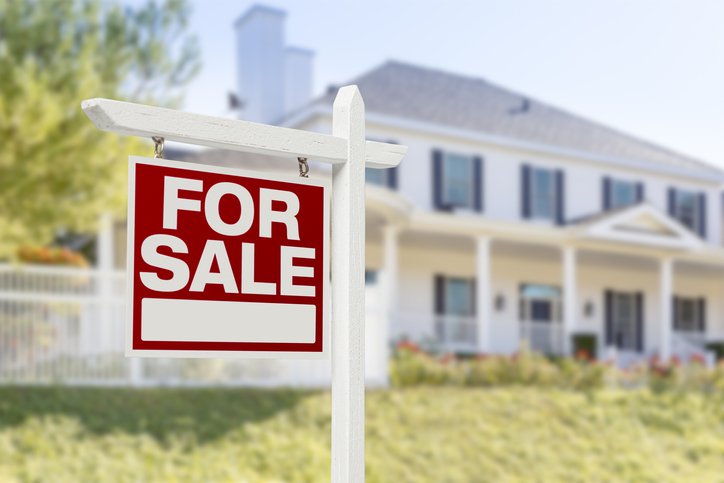
Image source: Getty Images
New home sales dropped by 17%.
Key points
- New single-family home sales have dropped to an annual pace of 591,000 units in April, according to a report from the U.S. Census and HUD.
- Interest rates have climbed over 2 percentage points since the start of the year, costing $500 more for a typical mortgage.
- Sales of new homes fell for the sixth straight month in May as record prices and high mortgage rates collide.
After a record-breaking year for home prices, home sales are starting to slow down as mortgage rate increases and high housing prices impact demand. Sales of new single-family homes dropped to a seasonally adjusted annual rate of 591,000 units in April, according to a report from the U.S. Census Bureau and Department of Housing and Urban Development. This is 17% below the March rate of 709,000 homes and 27% lower than the April 2021 estimate.
This is the slowest pace since April 2020, right as COVID-19 and the lockdowns impacted the global economy. The report indicates that the buying frenzy may be starting to lose momentum. The Federal Reserve has raised interest rates twice this year and have said more interest rate hikes are likely to come later this year to slow inflation. Homeownership is becoming more out of reach for many Americans as high interest rates collide with record prices.
Home affordability is an issue
The rate on a 30-year fixed-rate mortgage now averages 5.09%, the highest since April 2010. Mortgage rates have climbed over 2 percentage points since the beginning of the year. The combination of the largest spike in mortgage prices in nearly four decades and rising home prices means a monthly mortgage payment is 52.5% higher than it would have been a year ago.
This dramatic increase is $500 more for a typical monthly mortgage compared to earlier this year. Many borrowers, due to debt-to-income ratios, are now unable to qualify for loans. Many others are starting to draw the line at these high prices and are waiting on the sidelines until home prices become more affordable.
Home buyers are feeling anxious and unprepared
In a recent survey conducted by TD Bank, 67% of first-time home buyers said they were concerned with their ability to afford a home, and 65% said home prices were too expensive. Only 36% believe it is a good time to buy a home, compared to 59% in 2021 and 68% in 2020. With 7 out of 10 worried about the economy, sales of new homes fell for the sixth straight month in May.
The U.S. Census report showed the median sales price of a new home rose 19.6% from a year earlier, to a record $450,600. With prices this high, more Americans are unable to afford the typical 20% down payment of over $90,000. This is nearly 50% higher than the down payment needed for a home purchased in 2019, right before the pandemic.
The report also indicated that there were 444,000 new homes for sale as of the end of the month, the most since 2008. Home buyers’ pessimism is likely beginning to take hold of the market, resulting in new home sales plunging to pandemic-era lows.
U.S. home values continue to grow at a record pace, up 20.9% in the past year. Even though inventory remains 48% below pre-pandemic levels, the housing market is beginning to show some signs of cooling down.
Inventory is beginning to rise
According to the Commerce Department, U.S. homebuilding starts unexpectedly rose in March by 3.9% from the previous year. Building permits, which are a leading indicator for residential construction, increased by 6.7% from the previous year. These numbers show that homebuilders are increasing supply to meet demand and may be the break that prospective homeowners need.
Existing home inventory has continued to rise as well, up 5.5% from March, the second straight month of growth. The inventory deficit compared to a year ago has also shrunk in each of the past three months. More inventory leads to a more balanced housing market: With more homes to choose from, it limits the number of buyers bidding on each home and prompts sellers to price their homes competitively.
While home prices are still expected to rise, the combination of high prices and more inventory has led to Zillow revising its future forecasts from 14.9% growth for the next year down to 11.6%. Its forecast for existing home sales has been lowered as well, now predicting 5.73 million sales for this year, a 6.4% decrease from 2021.
The Ascent’s Best Mortgage Lender of 2022
Mortgage rates are on the rise — and fast. But they’re still relatively low by historical standards. So, if you want to take advantage of rates before they climb too high, you’ll want to find a lender who can help you secure the best rate possible.
That is where Better Mortgage comes in.
You can get pre-approved in as little as 3 minutes, with no hard credit check, and lock your rate at any time. Another plus? They don’t charge origination or lender fees (which can be as high as 2% of the loan amount for some lenders).
Read our free review
